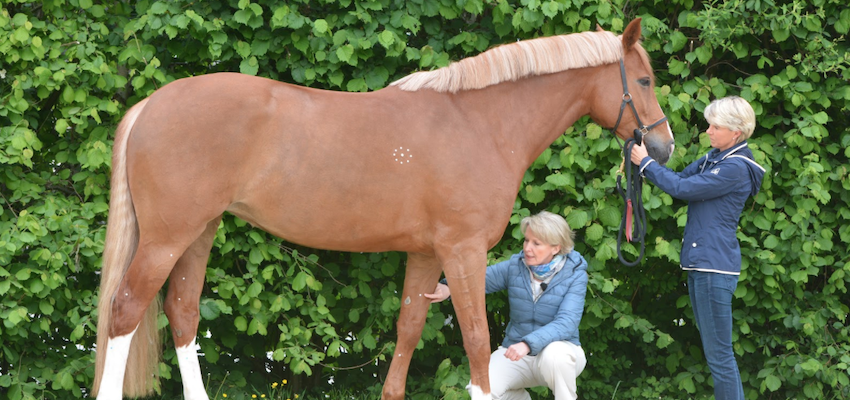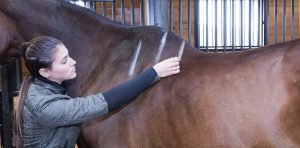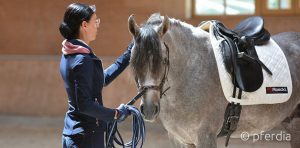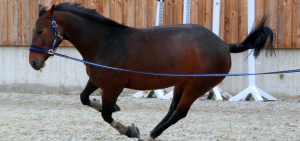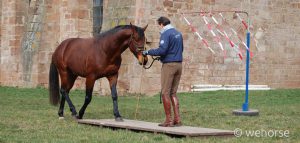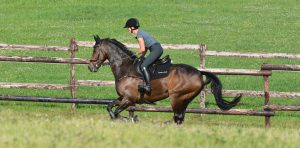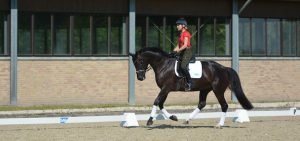In this article, you will be introduced to the fundamentals of equine acupressure and will find out what this component of Traditional Chinese Medicine is all about and how it can be used to help horses. You can also try it out for yourself with the help of our manual and overview on how to acupressure a horse.
Summary
- What Is Equine Acupressure?
- How Does It Work?
- The Acupressure Techniques
- Assessing the Horse Type
- How to Prepare Yourself for Acupressure?
- What Are the Equine Acupressure Points?
What Is Equine Acupressure?
Acupressure comes from Traditional Chinese Medicine and is a part of three treatments and healing methods: The first one is acupuncture which probably is most known and commonly used. Acupressure belongs to Acupuncture. The second component is phytotherapy or also known as herbalism. And the third component is movement- and breathing therapy. Acupressure can’t heal but is used as additional support for the other treatment methods.
It can be used as a treatment for pain and internal conditions as well as for behavioral problems. The main difference between acupuncture and acupressure is that there is no penetration with the needle, only pressure. Acupressure can not only be used on horses, but also on other animals.
How Does It Work?
There are 365 Acupuncture points lying on the 12 meridians. Every single acupressure point has about 5 functions. The meridians are special paths where vital substances flow. These vital substances are: Essence, Spirit, Blood, Body fluids, and Qi. In acupressure, the focus lies on the Qi because this treatment only has an impact on this particular vital substance. An even flow of Qi keeps the body in harmony because an organism is healthy when it is in complete energy balance within itself and its environment. A lack or stagnation of Qi however causes pain or illnesses. A lack of Qi can be detected by a cold area on the horse’s body.
The goal of equine acupressure is to harmonize the horse mentally and to give him back his state of well- being. If the horse’s unwell condition is caused by lameness, serious injuries, or illnesses, it is of course necessary that a vet is called!
Because all illnesses have not only a physical but also mental component, it is important to know one’s horse reaction to work, stress, pain, and therapy. This knowledge helps to assess its particular type which influences the acupressure technique and the acupressure points on the horse’s body. The type is determined by the theory of the 5 phases of transformation.
These five transformation phases consist of five elements: Water, Wood, Fire, Earth, Metal. Each element is associated with two organs:
- Water: Bladder, Kidney.
- Wood: Liver, Gallbladder.
- Fire: Heart, Small intestine.
- Earth: Stomach, Spleen.
- Metal: Lungs, Large intestine.
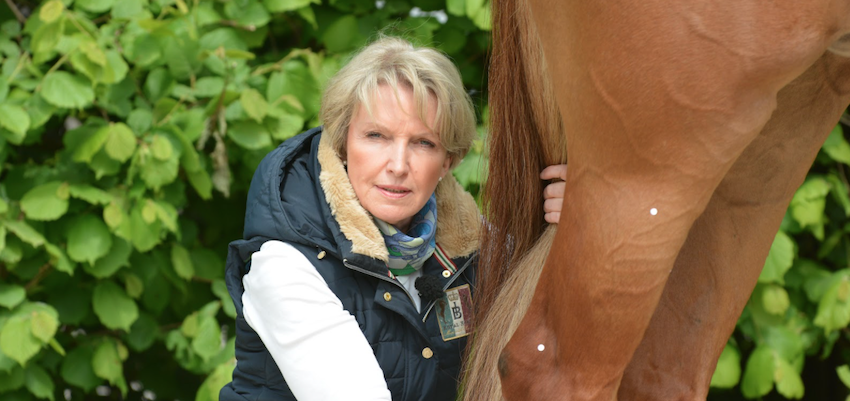
The Acupressure Techniques
There are several criteria that decide how acupressure is to be applied to a horse. First of all the psyche and social behavior of the horse are indicators that determine what kind of treatment is suitable. Then the rideability and the physical characteristics come into play. They are determining factors for judging the horse’s type according to the five transformation phases. Depending on these criteria, a matching acupressure technique and acupressure point is decided.
There are three different acupressure techniques. The balancing technique has a harmonizing effect and should last approximately one minute. Then there is the Yin technique which has a soothing effect on the horse. It lasts around two minutes and is applied with a bit more pressure. The Yang technique has a stimulating effect and only lasts 30 seconds. This technique is to be applied with only slight pressure.
In all of these techniques, the finger that is placed on the acupressure point moves clockwise. The pressure of the finger is dependent on the horse’s sensitivity, reaction, and thickness of coat. So it is adjusted individually to each horse. If the horse starts to chew and close his eyes, this is a very good sign and shows that the treatment has a soothing and relaxing effect on the horse.
Assessing the Horse Type
According to Traditional Chinese Medicine, there are five types of horses that can be determined by their character, physical characteristics, and their tongue- behavior. These types can be found in all breeds.
The types of horses in Traditional Chinese Medicine are:
- Liver- Gan-Typ
- Spleen- Pi-Type
- Kidney- Shen-Type
- Lung- Fei-Type
- Heart- Xin-Type
The type of horse influences the application of equine acupressure and determines the choice of acupressure points, the acupressure technique and the acupressure intervals. But how to judge which kind of type your horse is? There are a few physical and mental features that help with assessing the horse type.
The Spleen- Pi-Type
This type has a deep and slow pulse. He has a big mouth with a soft bottom lip. The musculature is soft and the joints are prominent. This type has a tendency for a hanging belly. It would give you his tongue voluntarily and likes to have it massaged. He is kind in handling and gets along in a herd very well. While riding, this type of horse is rather sluggish and a slow learner. It is helpful for this type if you do interval training and praise him a lot. It’s important you give him the time he needs due to his disposition of being a slow learner.
The Liver- Gan-Type
This type is often an eye-catcher due to his tense and prominent musculature. You can also detect this type by his red mucous membranes. This horse is very dominant in handling and in the herd. He wouldn’t give you his tongue voluntarily and he can become very upset. He is a fast learner but not very cooperative. If your horse is a liver- gan type, you should train your horse well but don’t break it.
The Kidney- Shen-Type
This type is often cold around the lumbar spine area and has a small and whitish tongue, dry joints with a weak developed musculature and a small and fast pulse. He would be very insecure when asked to give his tongue which has to do with his little confidence. Mentally, this type is very anxious which is why he orientates himself at the rider or other horses and thus is easily influenced by the environment. He is very eager and fast in comprehension but can suffer long from illnesses and tends to respiratory diseases in winter due to his transformation phase water. If you have to do with this type of horse, then encourage him, train a lot, and do many repetitions to establish security. Also, make use of your voice to influence him.
The Lungs- Fei-Type
This type has pink and dry mucous membranes, a dry head, dry joints, and is overall physically not very impressive.
However, this type has a kind disposition, a very clear mindset and is therefore often found in eventing due to his ability to perform. He tends to respiratory diseases because of his transformation phase metal. It is important you observe this type of horse carefully because diseases are often overseen since these horses tend to not show it.
The Heart- Xin-Type
This type is very rare and occurs more often in combination with other types. These horses tend to after- sweat long after the training. A heart- xin type can panic out of nowhere and is very hard to train or to calm down. He fixates on only one horse and is very difficult to integrate into a herd.
How to Prepare Yourself for Acupressure?
If you plan to apply equine acupressure on your horse, it is important to prepare yourself. The first requirement that has to be met is that you come to the stable in a relaxed and content mood otherwise the acupressure won’t be successful.
- Now lay your right hand below the navel and the left hand on top of it.
- Then shut your eyes and breathe five to ten times deeply into this area because there lies your center of energy.
- Relax, drop your shoulders and concentrate: The goal is that the Qi from the conception vessel flows directly into the navel area.
- If you feel composed, you open your arms and rub the palms of your hands together.
- Take your left hand and stroke it over the back of your right hand, right down to your fingertips!
- Then rub your hands together again.
- Then take your right hand and stroke it over the back of your left hand till the fingertips: The stroking activates the Qi in the fingertips.
- Rub the hands together again.
- Then make a fist with your right hand and tap with it on your left arm, beginning from your fingertips and going up to your shoulder: This activates the Yin- meridians. Now tap back down from the shoulder to the fingertips on the outside of your arm.
Do the same on the other side, so you have the possibility to acupressure with your left or also your right hand.
Keep in mind that you greet your horse first before you start with the acupressure. Take a good look at your horse and ask yourself: How does my horse look? What is the current feeding condition? Is my horse a restless or relaxed type? If you have determined the type of your horse, you can start to touch your horse with the outside of your hand (your hand is more sensitive on the outside) and try to feel if you can sense any cold or sensitive spots on your horse. Stay close to your horse, he is also allowed to move closer to you while you acupressure. The closeness is important, so you can detect any changes in his behavior. Always keep contact with both your hands on the horse. If you go to the hindlegs of your horse, make sure someone stands before the head to hold him in case something happens.
Don’t get impatient if you don’t see a sudden result after applying equine acupressure: Have you been using the right technique? Did you acupressure the right point? Have you found your own center of energy by using the right preparation steps?
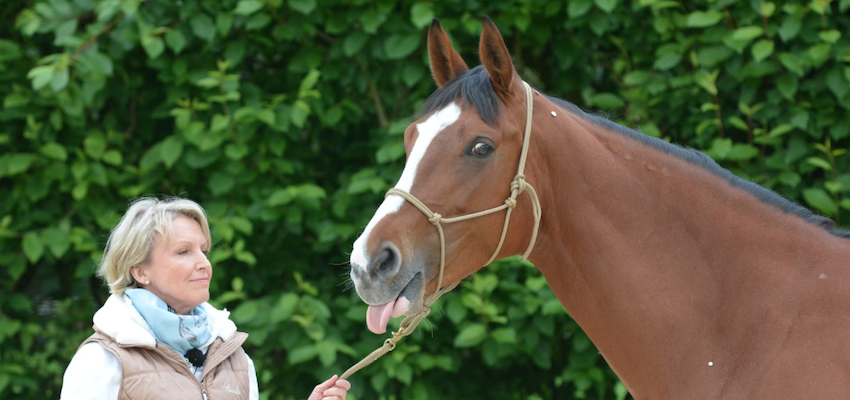
What Are the Equine Acupressure Points?
The Spleen- Pi-Type: Spleen 6 is the point where the three Yin- Meridians join up. It is treated with the Yan technique. It stimulates the Pi- Type and generates Qi and blood and it helps with the fluid content of the legs (e.g. swollen legs). This point is located on the inside of the hindleg, a hand width above the hock and on the edge of the tibia.
The Liver- Gan-Type: Liver 3 is to be acupressured in the Yin technique. It has an harmonizing effect on the Liver- Type and causes the liver Qi to distribute over the whole body. This point is located on the inside of the hind leg, below the hock and behind the top of the ergot.
The Kidney- Shen-Type: Kidney 3 is to be acupressured in the Yang technique. It activates the kidney essence and gives strength to spirit and body. This point is located on the inside of the hind leg between the bulge of the hock and the tibia.
The Lungs- Fei-Type: Lung 7 connects the lung to the chinese kidney. This causes the Qi to flow and maintains the ability to perform by giving an energy kick. This point is located on the inside of the foreleg, a hand width above the knee and on the front edge.
The Heart- Xin-Type: To influence the mentality of this type, acupuncture is needed. Acupressure can only help with physical problems: Point Heart 7 and Bladder 15 help with back and neck pain and they help with the after-sweating problem of this horse type. Heart 7 is located on the inside of the foreleg, a hand width above the knee and on the back edge. Bladder 15 is located behind the shoulder blade, a hand width below the withers.
For more information on this topic, take a look at our trainer Ina Gösmeier.

